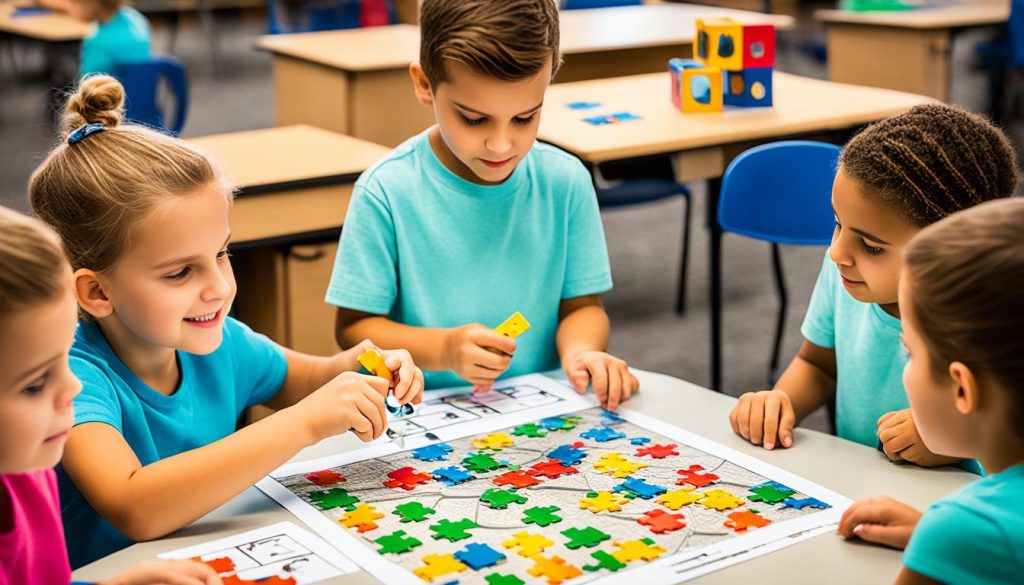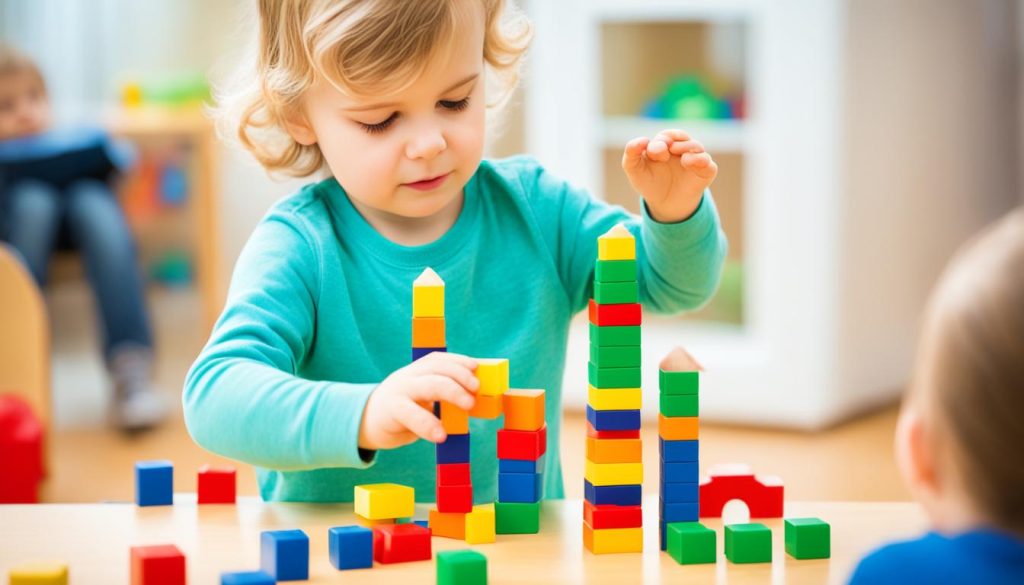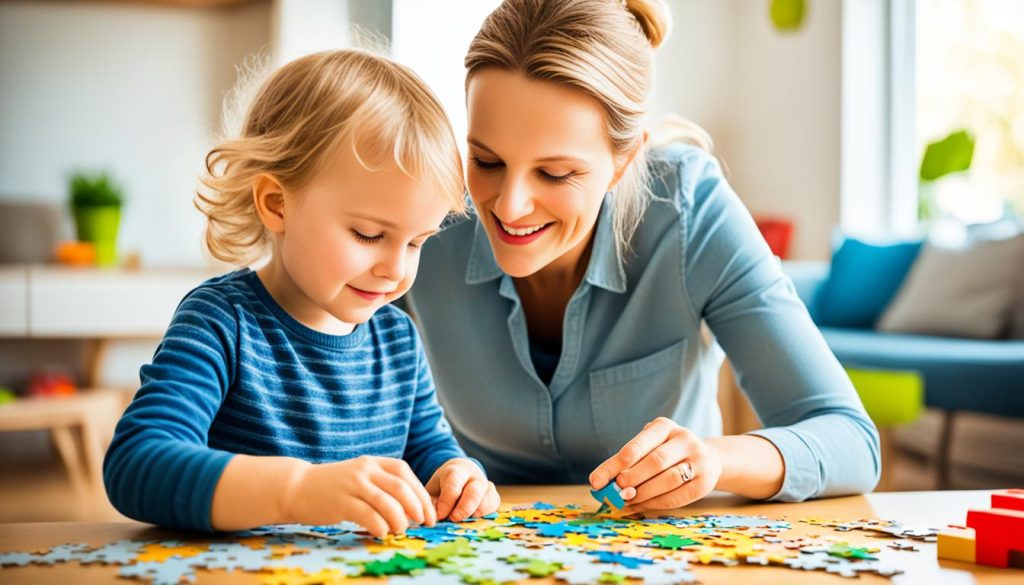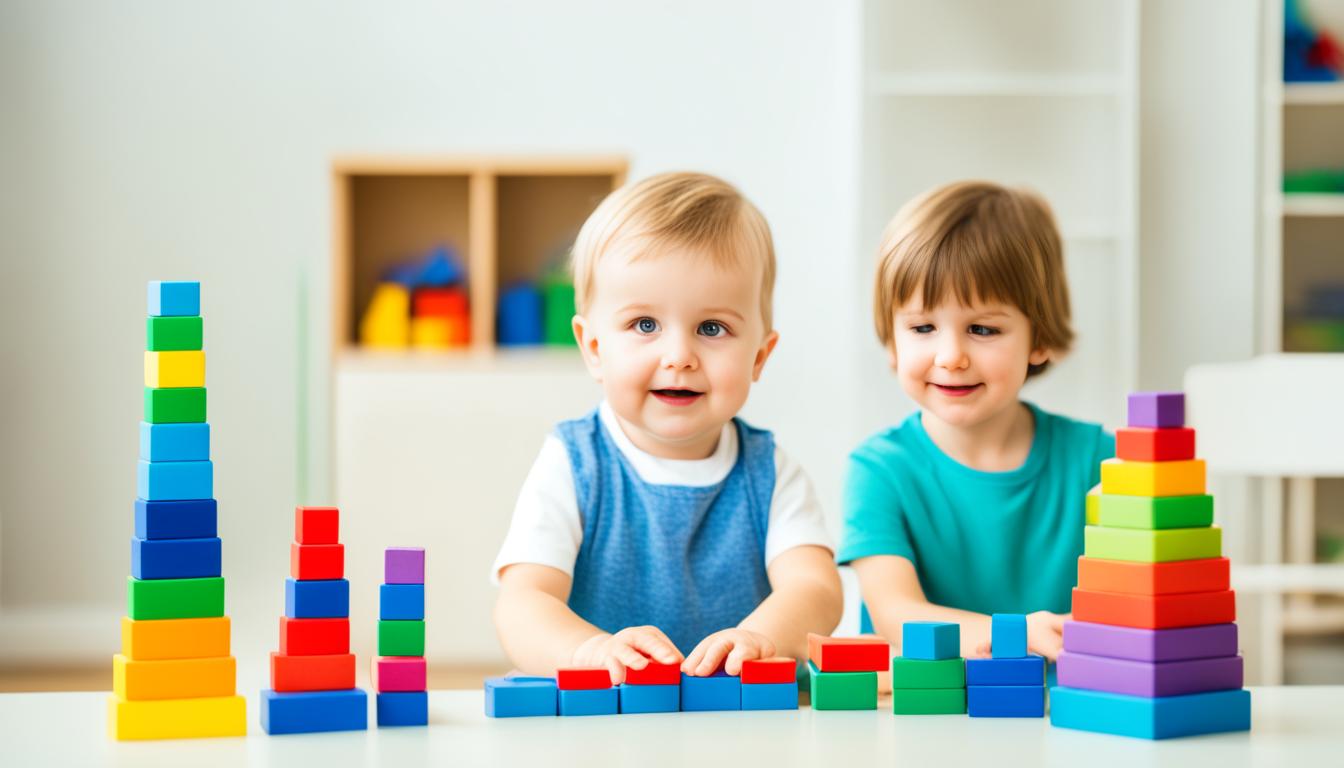Watching your child figure out a challenge is truly special. It could be building a tower with blocks or sharing toys with a sibling. These moments are key in your child’s growth. As a parent, you play a big part in helping your child develop problem-solving skills. This is crucial for their future success and confidence.
Problem-solving is a skill that can be learned, not just something you’re born with. It takes patience, creativity, and letting your child tackle challenges on their own. You should guide them but also give them space to be independent. Seeing your child solve a problem shows you how proud you are of them and reassures you they’re on the right path.
Seeing kids solve problems is a joy of parenting. As parents, we help shape our children’s problem-solving skills. This prepares them for success in school, leadership, and social life. Ways to help include being creative, patient, playing problem-solving games, thinking out loud, letting them fail, and praising their efforts.
Key Takeaways
- Encouraging problem-solving skills in your children lays a strong foundation for future success.
- Parents’ behaviors significantly influence their children’s ability to develop constructive problem-solving skills.
- Early engagement in problem-solving activities promotes independence in children as young as two years old.
- Allowing space for failure and self-correction fosters resilience and critical thinking.
- Praising efforts rather than just results boosts long-term motivation and confidence.
Introduction to Problem-Solving Skills for Children
Problem-solving is key for kids every day, in school, with friends, and at home. It helps with big milestones like thinking better and making choices. When kids solve problems on their own, they grow a mindset that helps them keep going and adapt.
A six-step approach to solving problems can help kids deal with conflicts and make smart choices. This method makes them better at handling challenges.

Getting kids to solve problems helps build their confidence. When parents ask for their help, it shows that mistakes are chances to learn. This builds their confidence and makes them more resilient for the future.
Teaching problem-solving in school works well. At Marlborough middle school, kids learn to solve problems alone and with others. Activities that simplify complex problems help them reach important milestones and understand the world better.
These skills also make them do better in school and prepare them for their careers.
Kids start using technology early, getting tablets at 5, smartphones at 8, and laptops at 10. Tools like coding classes teach them to keep going and plan well. A study in 2023 by the National Library of Medicine shows that strong problem-solving skills help kids feel better emotionally and reduce suicidal thoughts.
The Importance of Creative Play in Problem-Solving
Creative play is key to helping kids solve problems. It boosts their emotional, cognitive, and social skills. By encouraging creativity through play, kids learn to think outside the box and solve problems in new ways.
The role of play in child development is huge. It helps kids explore with their senses, improve their motor skills, and understand space. This makes them better at solving problems.
Utilizing Open-Ended Toys
Open-ended toys like LEGO and art supplies are great for nurturing child creativity. They let kids play in their own way, boosting their problem-solving skills. These toys help kids see things from different angles.
These toys also spark imagination. Kids learn to think creatively when they build, draw, or create. This helps them solve problems from many sides.

Fostering Imagination Through Play
Dramatic play is great for kids’ emotional, social, and cognitive growth. It lets them act out scenarios like running a store or being a doctor. This helps them understand others and work together.
Unstructured play, like pretending or playing with animals, also helps. It lets kids tell their own stories and solve problems. This can reduce stress and boost creativity.
Playing with kids from different backgrounds can make them more creative. It helps them see the world in new ways. So, it’s important for adults to let kids lead in play. This way, kids learn to work together and come up with new ideas.
Modeling Effective Problem-Solving as a Parent
As a parent, showing how to solve problems is key. It’s about more than just the answers. It’s about the steps you take to find them. This helps a lot in talking well with your kids. By being a good example, you teach your kids how to solve problems by themselves.
Thinking Aloud
Thinking out loud is a powerful way to show how to solve problems. It lets your kids see the steps you take. For instance, saying, “I need to organize my schedule better. First, I’ll make a list of tasks, then sort them by priority,” helps them see how to tackle a big problem.

Talking out your thoughts also makes it easier for your kids to share theirs. This helps both of you learn from each other. Studies show kids learn by watching how parents solve problems together. Seeing parents handle conflicts well helps kids manage their feelings better.
Demonstrating Patience and Persistence
Showing patience and not giving up is also important. When you stay calm, your kids learn to keep a cool head too. It shows them that setting boundaries means being steady, not pushy.
Being positive and owning up to your actions teaches kids good problem-solving. This is a key part of being a positive parent. Talking openly at home and letting kids help with decisions teaches them about teamwork and solving problems together.
| Parent Behavior | Child Outcome |
|---|---|
| Thinking Aloud | Improved cognitive processing |
| Maintaining Patience | Better emotional regulation |
| Setting Boundaries | Understanding persistence |
Emotional Coaching for Better Problem-Solving
Teaching emotional intelligence to children is key for their growth and solving problems. Emotional coaching helps your child manage their feelings. This builds a strong base for tackling life’s challenges.
Naming and Validating Emotions
Start by helping your child identify and accept their feelings. It’s vital for emotional smarts. When they can say what they feel, they can handle those feelings better. This also supports their mental health by making sure their feelings are seen and understood.
Creating a Calming Space
A calm space is key for dealing with tantrums and big feelings. Letting a child have a quiet place helps them feel and think about their feelings without more stress. This spot should be quiet, letting them focus on their feelings and calm down.
Processing Emotions Together
Talking about feelings with your child is important. This close talk strengthens your bond and shows them how to deal with feelings. Working on feelings together helps them learn to manage emotions and solve problems for life.
Dr. John Gottman’s work shows emotional coaching is key for emotional growth. It means knowing a child’s feelings, listening well, helping them name their feelings, and guiding them in solving problems.

- Being aware of the child’s emotions.
- Recognizing expressions as teaching moments.
- Listening with empathy.
- Helping the child label emotions.
- Setting limits while problem-solving.
Using these steps in daily life makes your child feel heard and valued. This leads to better problem-solving skills.
Incorporating Problem-Solving Games
Adding problem-solving games to a child’s daily activities boosts critical thinking and helps their brain grow. These games teach important skills like planning and working together. They are key in teaching kids to be responsible and resilient.
Board and Strategy Games
Games like chess, checkers, and Monopoly are more than fun. They help improve problem-solving skills. Playing these games helps kids think better and make decisions.
Strategy games teach patience and the value of planning ahead. Kids learn to make plans and predict outcomes. This helps them solve problems better.
Outdoor and Team Games
Outdoor and team games have many benefits. Games such as soccer and capture the flag build resilience and support outdoor play. They make kids work together towards a goal, improving teamwork and social skills.
Outdoor games also help kids face real challenges and take more responsibility.
The game-based learning market is expected to hit 24 billion U.S dollars by 2024. This shows how important games are for learning new skills. Games make learning fun and improve how well students do in school.
When parents join in on game-based learning, the results get even better. This highlights how games help teach kids to be responsible and resilient through outdoor play.
Encouraging Independence and Self-Confidence
Helping kids become independent is key to their growth. Working moms often focus on raising kids who can handle tasks by themselves. Kids raised by working moms often start doing their laundry early, around 10 or 11.
Encouraging kids to make decisions and speak their minds helps build their self-esteem. When kids step out of their comfort zones, they learn new skills. Creating a space that supports independence helps them gain confidence and solve problems.
Building confidence comes from positive feedback. It’s about celebrating their efforts, not just their results, and setting and reaching goals. Keeping an achievement board at home shows off their wins and boosts their confidence.
Teaching kids within their “zone of proximal development” helps them solve problems on their own. Seeing failure as a chance to learn helps reduce anxiety and boosts productivity. This way, kids see failure as part of learning, not a defeat.
Parents might try to fix everything to avoid their kids failing, out of fear of rejection. But moving from a fixer parent to a consultant parent helps kids learn to solve problems by themselves. This change helps build their self-esteem and lets them take risks and learn from them.
Changing how you parent to be more of a guide helps your child grow. Encouraging them to take risks and face challenges makes them more resilient and self-reliant. This shapes them into confident and independent people.
Using Open-Ended Questions to Stimulate Thinking
Open-ended questions are great for talking with your child. They help spark their thinking and get them to dive deeper into solving problems. Unlike simple yes or no questions, they make kids think more about their answers. This helps them become more independent and creative in many situations.
Examples of Open-Ended Questions
Here are some open-ended questions you can use to talk with your child:
- What do you think would happen if…?
- How would you solve this problem?
- Can you tell me more about your idea?
- What could we try differently next time?
- Why do you think that happened?
- How do you feel about this?
Benefits of Open-Ended Questioning
Open-ended questions have many benefits:
- Empowers Thought Sharing: Kids feel safe sharing their thoughts and ideas.
- Encourages Critical Thinking: Makes kids think deeply and see things from different angles.
- Fosters Creativity and Imagination: Helps them think creatively and solve problems.
- Builds Confidence and Self-Expression: Gives them a space to express themselves, boosting their communication skills.
- Nurtures Problem-Solving Abilities: Encourages them to think outside the box and explore different solutions.
- Promotes Language Skills: Improves their speaking, writing, and understanding of language.
Statistical Data:
| Aspect | Impact of Open-Ended Questions |
|---|---|
| Thought Sharing and Expression | Helps kids share their thoughts, leading to better communication with parents. |
| Critical Thinking | Makes kids think deeply, analyze situations, and see things from other viewpoints. |
| Creativity and Imagination | Boosts creativity and imagination in children. |
| Confidence and Self-Expression | Encourages kids to speak their minds, building their confidence. |
| Problem-Solving Skills | Helps kids develop problem-solving skills for future challenges. |
| Language Development | Improves language skills by encouraging meaningful conversations. |
Teaching Problem-Solving Steps by Age Group
It’s important to adjust problem-solving strategies for different ages. This matches the child’s growth stages. Each stage needs its own approach to help kids develop good problem-solving skills.
Preschool Age Strategies
Children aged 3-5 need a strong start in problem-solving. Emotional coaching and simple activities are key. Creative play and storybooks introduce them to solving problems.
Emotion coaching prepares preschoolers for problem-solving. Hands-on activities like puzzles and role-playing teach them to tackle small problems.
School Age Strategies
For kids aged 5-7, a structured method works well. Teaching them to solve problems step by step boosts their thinking and life skills. A five-step plan is helpful:
- Identifying emotions
- Understanding the problem
- Brainstorming potential solutions
- Considering consequences
- Trying a selected solution
Activities like complex puzzles, craft projects, and family discussions help improve problem-solving. Encouraging kids to think of their own solutions and giving feedback supports a growth mindset.
Teenage Strategies
Teens face tough issues and need better decision-making skills. Encouraging independence and critical thinking is key. Talking about global issues, family decisions, and the future helps them grow.
Good teaching methods include group projects and strategy games. Talking about their goals and celebrating their successes builds a positive mindset.
Strong partnerships between parents and teachers are vital at all ages. Good communication helps kids do better in school and life. For tips on supporting your child’s mental health, click here.
Allowing Room for Failure and Learning
Letting kids fail is key to building resilience. Helicopter parenting starts early and can get in the way. Jessica Lahey says overprotective parents have hurt a whole generation’s growth and potential. Letting kids fail teaches them the value of trying again.
A DePaul University freshman spoke about the fear of failure from constant pressure to get into a top college. This over-involvement includes helping too much with homework and getting into friendship issues. It hinders the growth of good discipline.
Jessica Lahey believes letting kids fail builds resilience, motivation, and decision-making skills. Studies show kids who have parents who support their independence do better in challenges. When kids set their own goals, they’re more likely to achieve them and stick with activities longer.
Carlin Flora says failure is a normal part of life, no matter how hard you try. Knowing that intelligence can change and overcoming obstacles makes kids smarter. So, parents should let their kids fail to help them learn, discover themselves, and become resilient.
The 10,000-hour rule shows mastery comes with many failures. Every failure, big or small, is part of learning.
Not managing screen time well can hurt school performance, teaching kids to change their ways. Not doing chores right can show the value of being responsible, honest, and honest. Facing these issues helps kids make better choices.
Jessica Lahey’s advice matches Psalm 37:24, saying help is there in hard times. Parents should support, encourage, discipline, and guide their kids. Seeing failure as a chance to grow can lead to success. It’s not a failure, but a step towards resilience and solving problems.
Praising Effort Over Results
Praising kids for their hard work, not just their results, is key in positive parenting. This method boosts their motivation, confidence, and ability to tackle challenges. By focusing on the effort and process, you help them develop a mindset that encourages them to keep going and believe in themselves.
Examples of Positive Reinforcement
Specific and sincere praise is important for shaping good behavior. Here are some ways to praise positively:
- Descriptive praise: “I can see you worked very hard on this puzzle!” This kind of praise highlights the effort, making them more likely to do it again.
- Nonverbal praise: A thumbs up or high-five can be as powerful as words. It shows they’re doing well and should keep it up.
- Age-appropriate rewards: Small treats or special privileges can make praise even more effective. Make sure the rewards are different and not always given.
Regular and real praise helps kids see their strengths and grow more independent. It encourages them to make small improvements and always get positive feedback.
The Impact on Long-Term Motivation
Praising effort over results has big long-term benefits. Studies show that:
- Children praised for their effort are more likely to take on tough tasks, building a strong work ethic.
- Kids praised for being “smart” might stick to easy tasks to keep feeling good, which can hold back their growth.
- Positive parenting teaches kids to be thankful by recognizing their hard work and effort, not just the outcome.
Also, knowing that stress can improve performance helps reduce the stress hormone cortisol, making it easier to handle. Encouraging kids to see stress as part of learning makes them more resilient.
The Role of Storybooks in Teaching Problem-Solving
Storybooks are key in teaching kids about solving problems by offering scenarios that make them think deeply. Reading to your kids boosts their early reading skills like recognizing rhymes and letters. It also helps them understand different cultures and builds empathy. Adding storybooks to family time lets kids face challenges and find solutions through characters’ stories.
Storybook characters help kids connect with various situations, teaching them empathy and problem-solving. Reading aloud helps kids grasp big feelings and learn to handle them. It’s great for their social and emotional growth. Plus, it brings families closer by starting meaningful talks and shared moments. Here are some top storybooks for teaching kids to solve problems:
Recommended Storybooks
- Harold and the Purple Crayon by Crockett Johnson – A classic that sparks imagination and creative problem-solving.
- How to Catch a Star by Oliver Jeffers – Teaches kids about not giving up and the value of patience and persistence.
- The Most Magnificent Thing by Ashley Spires – Shows the importance of trying and learning from mistakes.
Engaging with the Story and Characters
To make these storybooks more impactful, engage with the story and characters. Here’s how:
- Ask open-ended questions: Encourage kids to think deeply about the story by asking, “What do you think Harold should do next?” or “How would you solve this problem if you were the character?” This helps their thinking and builds healthy habits.
- Discuss the characters’ emotions: Talking about the characters’ feelings and decisions helps kids understand others and develop emotional smarts.
- Relate the story to real life: Connecting the story to your kids’ real-life situations helps them apply problem-solving skills to real problems.
By making these storybooks part of your family’s routine, you create a caring space that values respect and empathy. This approach helps kids grow in both mind and heart. It also brings your family closer as you explore stories and solutions together.
Conclusion
As a parent, you are key in helping your kids develop problem-solving skills. This is vital for their learning throughout life. By using creative play, emotional support, and letting them make their own choices, you help them deal with tantrums. You also prepare them to face life’s challenges with confidence.
Parents have different ways of teaching their kids, but they all agree on some things. About 68% of parents say talking openly is important. 52% believe in being respectful and understanding. And 49% support letting each child make their own choices, showing the value of their unique qualities.
Keeping a strong emotional bond and a caring home helps your child grow emotionally. Research shows that kids with loving parents are less likely to feel sad or anxious. They’re also less likely to get depressed as teenagers. Using a mix of discipline and giving them freedom helps your kids feel important and ready to solve problems on their own.
FAQ
What are the key factors in encouraging problem-solving skills in children?
How does creative play contribute to problem-solving skills?
How can parents model effective problem-solving?
What role does emotional intelligence play in problem-solving?
What types of games can enhance problem-solving skills in children?
Why is fostering independence important for problem-solving?
How can open-ended questions stimulate a child’s thinking?
How can problem-solving strategies be tailored to different age groups?
Why is allowing children to fail important in the learning process?
What is the significance of praising effort over results?
How can storybooks be used to teach problem-solving?
This post contains affiliate links. If you click on a link and make a purchase, I may earn a small commission — at no extra cost to you. Thank you for supporting this blog and helping me keep the patterns free! Read the full Affiliate Disclosure & Transparency.
